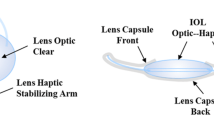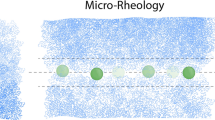Abstract
The surface chemical compositions of three types of silicone hydrogel contact lenses, PureVision® (balafilcon A), ACUVUE® OASYS® (senofilcon A), and O2OPTIX® (lotrafilcon B), were analyzed using X-ray photoelectron spectroscopy prior to and following treatment in a test solution of diblock copolymer of poly(ethylene oxide) and poly(butylene oxide) (EO–BO). Prior to treatment, differences in surface elemental compositions of the lenses were found to reflect known bulk compositions and/or respective surface treatments. Following solution treatment, surface chemical modifications were apparent in balafilcon A and lotrafilcon B, especially in the distribution of chemical functionalities present at the surface. Only modest changes in surface composition were observed for the senofilcon A material. Atomic force microscopy (AFM) was employed to evaluate the surface topography and frictional properties of the lenses prior to and following similar solution treatments. AFM measurements in saline revealed large disparities between the coefficients of friction of the three lenses, with balafilcon A and lotrafilcon B exhibiting coefficients of friction approximately five times greater than that of senofilcon A. Lens surface treatment with the diblock copolymer test solution produced a significant reduction in the coefficients of friction of the two lenses exhibiting higher friction, yet only a small reduction in friction was observed for senofilcon A lens. Together, these results depict a strong correlation between the surface chemistry and frictional response of the lens systems as they relate to solution treatment with this specific diblock copolymer.





Similar content being viewed by others
References
Guryca, V., Hobzová, R., Prádný, M., Sirc, J., Michálek, J.: Surface morphology of contact lenses probed with microscopy techniques. Contact Lens Anterior Eye 30, 215–222 (2007)
González-Méijome, J.M., López-Alemany, A., Almeida, J.B., Parafita, M.A., Refojo, M.F.: Microscopic observations of superficial ultrastructure of unworn siloxane-hydrogel contact lenses by cryo-scanning electron microscopy. J. Biomed. Mater. Res. B 76B, 419–423 (2006)
López-Alemany, A., Compañ, V., Refojo, M.F.: Porous structure of PureVision (TM) versus Focus® Night&Day (TM) and conventional hydrogel contact lenses. J. Biomed. Mater. Res. 63, 319–325 (2002)
Subbaraman, L.N., Glasier, M., Senchyna, M., Sheardown, H., Jones, L.: Kinetics of in vitro lysozyme deposition on silicone hydrogel, PMMA, and FDA Groups I, II, and IV contact lens materials. Curr. Eye Res. 31, 787–796 (2006)
Fonn, D.: Targeting contact lens induced dryness and discomfort: what properties will make lenses more comfortable. Optom. Vis. Sci. 84, 279–285 (2007)
Santos, L., Rodrigues, D., Lira, M., Oliveira, M.E., Oliveira, R., Vilar, E.Y., Azeredo, J.: The influence of surface treatment on hydrophobicity, protein adsorption and microbial colonisation of silicone hydrogel contact lenses. Contact Lens Anterior Eye 30, 183–188 (2007)
Nicolson, P.C.: Continuous wear contact lens surface chemistry and wearability. Eye Contact Lens 29, S30–S32 (2003)
Daniels, K.: Contact lens-induced dry eye. In: Agarwal, A. (ed.) Dry Eye: A Practical Guide to Ocular Surface Disorders and Stem Cell Surgery, p. 324. Slack Incorporated, Thorofare, NJ (2006)
Weikart, C.M., Matsuzawa, Y., Winterton, L., Yasuda, H.K.: Evaluation of plasma polymer-coated contact lenses by electrochemical impedance spectroscopy. J. Biomed. Mater. Res. 54, 597–607 (2001)
Teichroeb, J.H., Forrest, J.A., Ngai, W., Martin, J.W., Jones, L., Medley, J.: Imaging protein deposits on contact lens materials. Optom. Vis. Sci. 85, 1151–1164 (2008)
Cheng, L., Muller, S.J., Radke, C.J.: Wettability of silicone-hydrogel contact lenses in the presence of tear-film components. Curr. Eye Res. 28, 93–108 (2004)
Svitoa, T.F., Lin, M.C.: Tear lipids interfacial rheology: effect of lysozyme and lens care solutions. Optom. Vis. Sci. 87, 10–20 (2010)
Ketelson, H.A., Meadows, D.L., Stone, R.P.: Dynamic wettability properties of a soft contact lens hydrogel. Colloid Surf. B 40, 1–9 (2005)
Karlgard, C.C.S., Sarkar, D.K., Jones, L.W., Moresoli, C., Leung, K.T.: Drying methods for XPS analysis of PureVision(TM), Focus® Night&Day(TM) and conventional hydrogel contact lenses. Appl. Surf. Sci. 230, 106–114 (2004)
McArthur, S.L., McLean, K.M., St. John, H.A.W., Griesser, H.J.: XPS and surface-MALDI-MS characterisation of worn HEMA-based contact lenses. Biomaterials 22, 3295–3304 (2001)
Maldonado-Codina, C., Morgan, P.B., Efron, N., Canry, J.: Characterization of the surface of conventional hydrogel and silicone hydrogel contact lens by time-of-flight secondary ion mass spectrometry. Optom. Vis. Sci. 81, 455–460 (2004)
Opdahl, A., Koffas, T.S., Amitay-Sadovsky, E., Kim, J., Somorjai, G.A.: Characterization of polymer surface structure and surface mechanical behaviour by sum frequency generation surface vibrational spectroscopy and atomic force microscopy. J. Phys.: Condens. Matter 16, R659–R677 (2004)
Kim, S.H., Opdahl, A., Marmo, C., Somorjai, G.A.: AFM and SFG studies of pHEMA-based hydrogel contact lens surfaces in saline solution: adhesion, friction, and the presence of non-crosslinked polymer chains at the surface. Biomaterials 23, 1657–1666 (2002)
González-Méijome, J.M., López-Alemany, A., Almeida, J.B., Parafita, M.A., Refojo, M.F.: Microscopic observation of unworn siloxane-hydrogel soft contact lenses by atomic force microscopy. J. Biomed. Mater. Res. B 76B, 412–418 (2006)
Rennie, A.C., Dickrell, P.L., Sawyer, W.G.: Friction coefficient of soft contact lenses: measurements and modeling. Tribol. Lett. 18, 499–504 (2005)
Kim, S.H., Marmo, C., Somorjai, G.A.: Friction studies of hydrogel contact lenses using AFM: non-crosslinked polymers of low friction at the surface. Biomaterials 22, 3285–3294 (2001)
Maldonado-Codina, C., Morgan, P.B.: In vitro water wettability of silicone hydrogel contact lenses determined using the sessile drop and captive bubble techniques. J. Biomed. Mater. Res. A 83A, 496–502 (2007)
Menzies, K.L., Jones, L.: In vitro analysis of the physical properties of contact lens blister pack solutions. Optom. Vis. Sci. 88, 493–501 (2011)
Nace, V.M.: Contrasts in the surface activity of polyoxypropylene and polyoxybutylene-based block copolymer surfactants. J. Am. Oil Chem. Soc. 73, 1–8 (1996)
Larson, P.E., Kelly, M.A.: Surface charge neutralization of insulating samples in X-ray photoemission spectroscopy. J. Vac. Sci. Technol. A 16, 3483–3489 (1998)
Repoux, M.: Comparison of background removal methods for XPS. Surf. Interface Anal. 18, 567–570 (2004)
Vegh, J.: The analytical form of the Shirley-type background. J. Electron Spectrosc. 46, 411–417 (1998)
Tougaard, S., Jansson, C.: Comparison of validity and consistency of methods for quantitative XPS peak analysis. Surf. Interface Anal 20, 1013–1046 (1993)
Perry, S.S.: Scanning probe microscopy measurements of friction. MRS Bull. 29, 478–483 (2004)
Limpoco, F.T., Payne, J.M., Perry, S.S.: Experimental considerations when characterizing materials friction with atomic force microscopy. Tribol. Lett. 35, 3–7 (2009)
Bain, C.D., Whitesides, G.M.: Attenuation lengths of photoelectrons in hydrocarbon films. J. Phys. Chem. 93, 1670–1673 (1989)
Seah, M.P., Dench, W.A.: Quantitative electron spectroscopy of surfaces: A standard data base for electron inelastic mean free paths in solids. Surf. Interface Anal. 1, 2–11 (1979)
Lorentz, H., Rogers, R., Jones, L.: The impact of lipid on contact angle wettability. Optom. Vis. Sci. 84, 946–953 (2007)
Muller, M.T., Yan, X.P., Lee, S.W., Perry, S.S., Spencer, N.D.: Preferential solvation and its effect on the lubrication properties of a surface-bound, brushlike copolymer. Macromolecules 38, 3861–3866 (2005)
Muller, M.T., Yan, X.P., Lee, S.W., Perry, S.S., Spencer, N.D.: Lubrication properties of a brushlike copolymer as a function of the amount of solvent absorbed within the brush. Macromolecules 38, 5706–5713 (2005)
Perry, S.S., Yan, X.P., Limpoco, F.T., Lee, S.W., Muller, M.T., Spencer, N.D.: Tribological properties of poly(l-lysine)-graft-poly(ethylene glycol) films: Influence of polymer architecture and adsorbed conformation. ACS Appl. Mater. Interfaces 1, 1224–1230 (2009)
Brady, M.A., Limpoco, F.T., Perry, S.S.: Solvent-dependent friction force response of poly(ethylenimine)-graft-poly(ethylene glycol) brushes investigated by atomic force microscopy. Langmuir 25, 7443–7449 (2009)
Raviv, U., Frey, J., Sak, R., Laurat, P., Tadmor, R., Klein, J.: Properties and interactions of physigrafted end-functionalized poly(ethylene glycol) layers. Langmuir 18, 7482–7495 (2002)
Drobek, T., Spencer, N.D.: Nanotribology of surface-grafted PEG layers in an aqueous environment. Langmuir 24, 1484–1488 (2008)
Acknowledgment
This project was funded by a research grant from Alcon Inc.
Author information
Authors and Affiliations
Corresponding author
Rights and permissions
About this article
Cite this article
Huo, Y., Rudy, A., Wang, A. et al. Impact of Ethylene Oxide Butylene Oxide Copolymers on the Composition and Friction of Silicone Hydrogel Surfaces. Tribol Lett 45, 505–513 (2012). https://doi.org/10.1007/s11249-011-9902-7
Received:
Accepted:
Published:
Issue Date:
DOI: https://doi.org/10.1007/s11249-011-9902-7




